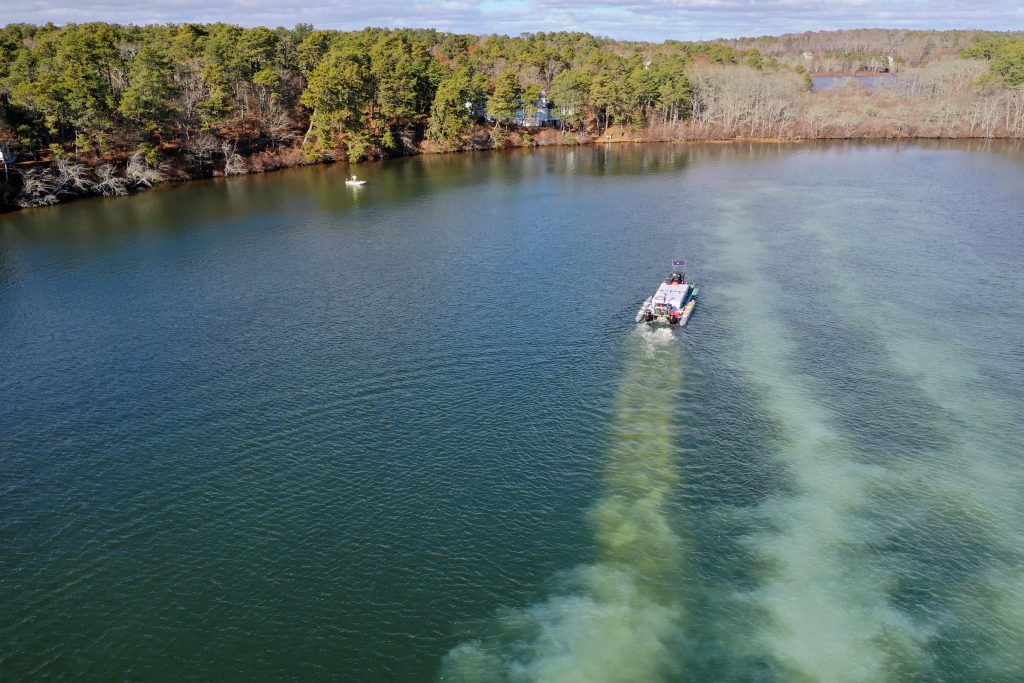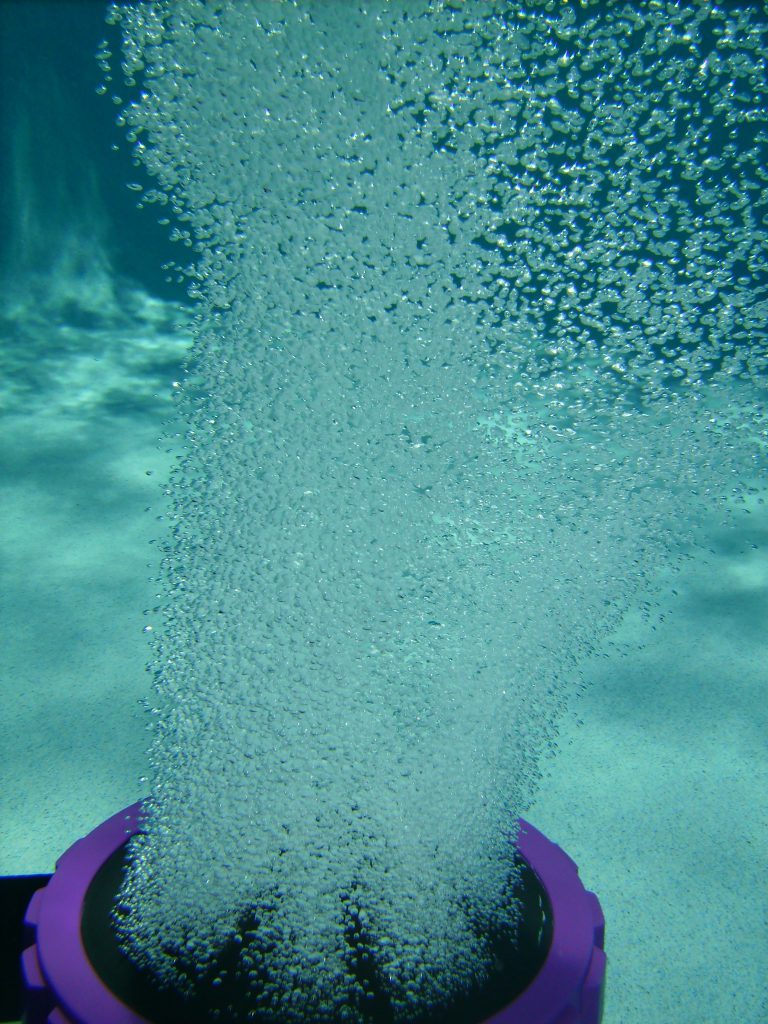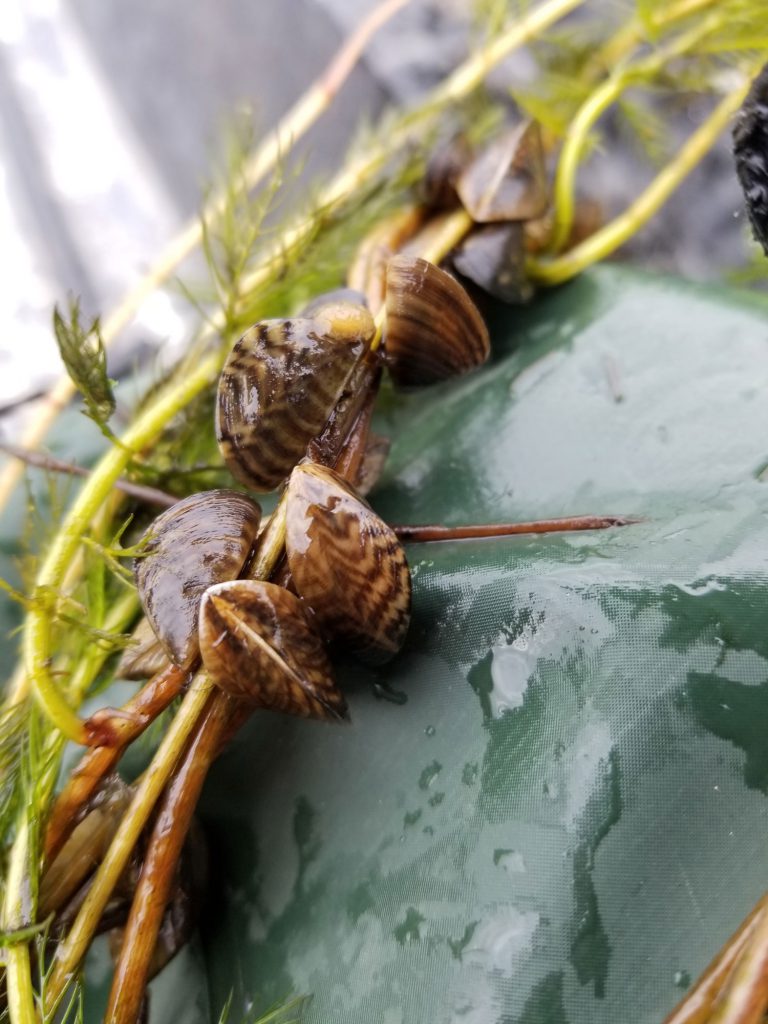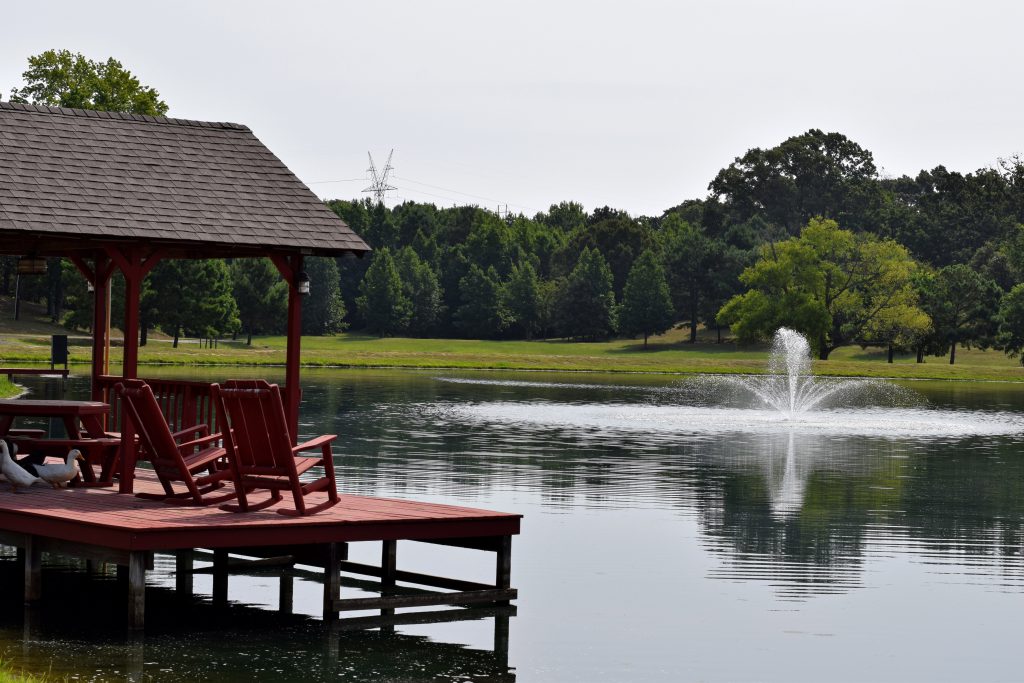
The State of Applied Lake Management: An Expert’s Perspective
As seen in Lakeline Magazine, a publication of the North America Lake Management Society (NALMS). NALMS’ mission is to forge partnerships among citizens, scientists, and professionals to foster the management and protection of lakes and reservoirs for today and tomorrow. Founded in Portland, Maine in 1980, this organization has grown into one of the largest societies in the lake and pond industry.
Similar to what has occurred with technology, the science of applied lake management has evolved considerably over the past three decades. This evolution has occurred partly because of scientific advancements and partly out of need. Pressures from continued development, agricultural practices, climate change, greater recreational usage and increasing water demands are adversely impacting lakes at an accelerated rate. Fortunately, there is greater awareness of the challenges, and applied lake managers now have more tools at their disposal than ever before.

Lake management needs and solutions vary considerably depending on the type of waterbody, its uses, geographic location and the particular challenges it is facing. Many of the old axioms remain true. First, every lake and pond is different. This needs to be taken into account as lake management plans are being developed. Assessment, monitoring and even permitting requirements must be appropriate for the size and type of waterbody, and for the management strategy being proposed. Second, prevention is the most effective form of management. No one can dispute the concept that preventing a highly invasive aquatic plant like hydrilla from being introduced to a lake is more preferable than trying to manage it once it’s established, or that eliminating nutrient sources in the watershed is better than trying to control harmful algal blooms (HABs) once they develop in a nutrient-rich system. However, the unfortunate reality is many of our lakes have already been adversely impacted, and in-lake management is often needed to preserve desirable conditions and to prevent further deterioration.
There are four major focus areas of applied in-lake management in most freshwater lakes, ponds and reservoirs: improving water quality, eliminating aquatic invasive animal species, managing problematic algal blooms, and controlling invasive and nuisance aquatic weed growth. Many of the techniques and strategies used to manage these challenges are similar, so this review will focus on where and how available approaches are used and what advancements have occurred in the industry in recent years.

Water quality improvement
Water quality improvement efforts by lake managers are usually directed at reducing excessive nutrients that can fuel nuisance algae and weed growth, and increasing circulation and dissolved oxygen concentrations that can benefit lakes on many levels. Focusing on improving water quality is generally viewed as proactive management – preventing problems from developing in the first place by addressing the root cause – as opposed to reactive management – controlling the symptoms like nuisance weed and algae growth once they develop.
Nutrient management in freshwater lakes usually targets reductions in excessive phosphorus and nitrogen concentrations. Once point sources and non-point sources of nutrient pollution are addressed in the watershed, there is often still a need to reduce nutrient levels in-lake due to years of loading and internal recycling processes. Phosphorus is the limiting nutrient in most freshwater lakes and treatment strategies focus on permanently binding phosphorus and rendering it unavailable for biological uptake. Salts of aluminum, iron and calcium are typically used, but several other compounds and polymers have and continue to be tested. Aluminum sulfate treatments are the most common and have the longest track-record of use, along with increased use of a modified bentonite clay that contains lanthanum. Lakes with small watersheds and long retention times where internal phosphorus loading is considerable can see years and sometimes decades of improvement from properly designed and executed phosphorus inactivation treatments.

Introduce Dissolved Oxygen
The other most common water quality improvement performed in lake management is circulation and the addition of dissolved oxygen. This can help prevent lakes from going anoxic which may prevent the release of nutrients from the bottom sediment that can fuel nuisance algal growth. Circulation and oxygenation can also help prevent the accumulation of other toxic compounds, promote the natural breakdown of organic debris and be beneficial to fish and most other aquatic organisms. The most common types of circulation aeration systems found in smaller lakes and ponds are surface fountains or mixers and bottom diffused aeration systems. Surface fountains and mixers are generally more efficient in shallow systems and oxygen is introduced through the mixing adsorption of atmospheric oxygen. Bottom diffused aeration systems are more efficient in deeper waterbodies where the rising bubble plumes produced by on shore air compressors cause the bottom water to rise to the surface where oxygen is introduced. Both types of systems are particularly beneficial in smaller, man-made lakes that serve as stormwater retention basins or in ponds that refilled using reclaimed water. Proper sizing often becomes challenging in larger, deeper lakes that may already be more readily mixed by wind driven currents. Hypolimnetic aeration and oxygenation systems are usually reserved for deep lakes and reservoirs with specific mixing and oxygenation goals.

Innovative Lake & Pond Management Solutions
Newer to lake management technology is Oxygen Saturation Technology (OST). OST is a patent-pending innovation used to administer precise concentrations of oxygen at strategic depths in a waterbody. Unlike other lake and pond aeration solutions, OST treats oxygen deficiencies in areas specifically targeted based on the position and volume of anoxic water. OST systems are equipped with suction and discharge lines that pull water into an onshore chamber. Inside, oxygen is injected at low pressure to fully dissolve and incorporate it into the water. The enriched water is then dispersed across and into the bottom sediments, where it will remain without flowing up and down or altering thermal stratification.
Another technology is the use of nanobubble generators that produce ultra-fine bubbles that are thousands of times smaller than conventional aerators. Nanobubbles have a neutral buoyancy and can remain in the system for days or weeks. This makes them potentially more efficient for oxygen transfer, and nanobubbles reportedly provide other benefits including oxidization of cyanobacteria. Research is ongoing to optimize the use of nanobubble generators for lake management needs, but early results are promising.
Introduction of beneficial bacteria and microbes is also gaining popularity in lake management. While this technique has long been used in operations at wastewater treatment facilities, water quality and bacteria concentrations are continuously monitored and adjusted to optimize performance. Designing natural and engineered bacteria that will work in the wide-range of water chemistry and site-specific conditions found in lakes and ponds has proven to be challenging, but the science continues to advance. Bacterial additives are often used in conjunction with aeration with the objective being that bacteria will out-compete algae for the available nutrients.

Aquatic invasive animal control
Since this review is not focused on fisheries, animal control in conventional lake management is usually limited to invasive mollusks, zooplankton, and crustaceans. Zebra mussels are the most recognizable aquatic animal being targeted by lake managers in North America, but quagga mussels, Asian clams, and several invasive aquatic snails can pose similar problems. They can clog pipes used for water supply and irrigation, adversely impact hydro-power facilities, alter habitat and smother native species. Colony-forming bryozoans can often reach problematic densities in ponds and clog irrigation lines, while spiny water flea and invasive zooplankton can greatly disrupt the food web and cause serious impacts to freshwater gamefish populations.
Considerable effort is directed at education and preventing transport and spread of aquatic invasive animals, but in-lake management is sometimes needed. Water treatment plants and hydro-power facilities sometimes use ultraviolet (UV) light and ozone generation systems, but to date, in-lake control has been limited to chemical treatments using copper and peroxide-based products. Treatments can be effective, but elevated chemical concentrations and exposure times are needed to control aquatic invasive animals compared to what is needed for algae or plant control, so treatments can have non-target impacts and must be carefully administered.

Algae management
Controlling nuisance algal growth is probably the most frequently occurring in-lake management activity being performed throughout North America. Once planktonic or free-floating algae or the filamentous mat-forming algae reaches bloom conditions, management efforts need to switch from the proactive management techniques used for water quality improvements to more reactive strategies that target control of the nuisance algal growth. Algae is present and necessary in all freshwater lakes and ponds, being the first stage of the food web, but opportunistic cyanobacteria and other harmful algal blooms (HABs) can multiple rapidly and reach noxious bloom conditions under favorable conditions. The frequency and severity of HABs seems to be increasing under the continued pressures from development and climate change and the need for in-lake algal control is not going away.
Dyes are commonly used in smaller ponds to block sunlight penetration and prevent nuisance algae from developing at the sediment and water interface where nutrients are usually most abundant. Dyes are usually blue or black in color and are non-toxic to aquatic organisms, but they do not work in all situations and are generally not as effective in a waterbody that regularly flushes.
Aside from the potential benefits that aeration and circulation may have at limiting algal growth, the only other mechanical control technique commonly used is sonication. This is where sonic waves are emitted at specific frequencies that lyse or break apart the algal cells. It can be effective for line of site applications, but single units have a limited range, it is not effective on all types of algae and it does require electricity to run the sonication devices.
Barley straw is used to control algae in smaller ponds. While the mechanism for control is still not completely understood, there is a chemical compound that is released as the barley straw decomposes that prevents algae from growing. Barley straw is not registered as an algal control product or device, so it is not typically utilized by licensed lake managers.
Treatment with registered algaecide products remains the most commonly used technique by lake managers once algal bloom conditions develop. Products that contain copper as the active ingredient are still most common and widely used. Various forms of copper sulfate and other copper complexes are used at low concentrations (<1 ppm) and are directly toxic to algae. Many of the common cyanobacteria and other nuisance planktonic and filamentous algae are highly susceptible to copper and can be controlled at low concentrations. Some copper complexes, usually chelates, are formulated with surfactants and adjuvants that are designed to keep copper in solution longer and aid in penetrating through the algal cell wall. These stronger formulations are often needed to control mat-forming filamentous algae and other types of macro-algae that resemble higher-level plants. Other commonly used algaecide are peroxides, usually hydrogren peroxide or sodium carbonate peroxyhydrate. Peroxides are generally viewed as having a safer environmental profile, but they are not as broadly effective as copper based products. Again, many of the noxious cyanobacteria are sensitive to peroxide algaecides, allowing for some selectivity in control. The key with any algaecide is treating when nuisance algae is developing, but when densities are still relatively low. Algaecide efficacy is directly linked to algal density. Treating at the beginning stages of an algal bloom will be more effective and reduce the risk of toxin release from HABs as the algae cells die back. Routine monitoring is critical in order to properly time algaecide applications.

Aquatic plant control
Managing overgrowth of nuisance aquatic plant growth is almost as common as algae control. While the majority of aquatic plant control efforts are focused on non-native or invasive species that have been introduced to freshwater systems, native aquatic plants can grow to nuisance densities in nutrient-stressed and manmade waterbodies. Reasons for managing aquatic plants may include aesthetics, access for recreational activities, water conveyance, preserving water quality, slowing eutrophication, and habitat preservation. Accurately identifying the types of problematic plants requiring management is the first step in determining the proper control technique to employ, but this can be complicated by the type of waterbody, size of the infestation, and use of the water. Eradication of nuisance and invasive aquatic plants is rarely achieved, so management techniques that are selected must be acceptable and sustainable to reach the desired outcomes.
Cultural and manual controls are usually focused on prevention and early detection – rapid response efforts. Educating lake users about the potential threat of invasive aquatic plants raises awareness and can result in effective control of new infestations. Boat ramp monitors, boat washing stations and educational material can be effective, but lake managers and stewards must remain vigilant. New infestations and low-density growth can sometimes be effectively controlled by hand-pulling and removal. The use of snorkeling and SCUBA equipment is usually required in water greater than four feet deep. In this method, plants are usually dislodged from the sediment and the entire plant including the roots are collected and removed from the waterbody. Lake managers will sometimes employ diver-assisted-suction harvesting (DASH) devices to help vacuum plants that are hand-harvested at depth into collection system on a surface mounted barge or boat to increase removal efficiency. Dense patches of nuisance plants can be controlled by bottom or benthic barriers (Figure 5) made of various fabrics that are weighted or staked to the bottom for a month or more to kill plants by compression and blocking sunlight. Hand rakes, weed rollers and shading barriers are also used for localized control. All of these strategies are best reserved for smaller infestations and lower density growth. The only physical control that can be effective for lake-wide infestations is winter drawdowns or water level lowering to expose the bottoms sediment to freezing and drying conditions in northern areas that are subject to freezing. However, this approach is subject to optimal conditions being achieved, having sediments that can adequately dewater and not all plants are effectively controlled by drawdown. Some plants like hydrilla have subterranean tubers that are not controlled, or plants that propagate by seeds or seed-like structures can gain a competitive advantage during drawdown conditions.

Biological Control of Aquatic Weeds
Biological control of aquatic plants is possible in some cases using herbivorous insects or fish. The use of insects is continually being studied as new aquatic invasive plants are introduced in North America, but to date only a few plants are being effectively controlled. Alligatorweed, water hyacinth, water lettuce, giant salvinia and melaleuca are being managed by specific weevils, beetles and flies in Florida and other southern states. Northern tier states have seen some success using weevils and beetles to control Eurasian watermilfoil and purple loosestrife. Most of the successful insect biocontrol programs are overseen by state or university researchers and are not being readily utilized by commercial lake managers. Probably the most effective biocontrol technique is the use of sterile or triploid grass carp (white amur). These fish have a voracious appetite for certain submersed plants. Hydrilla is well controlled by triploid grass carp and they are readily used as a management tool in everything from small ponds to large reservoirs. Of course, any biocontrol can be unpredictable, may go through typical oscillations of effectiveness and frequently require constant monitoring and adjustment.

Mechanical Control of Aquatic Plants
Mechanical control of aquatic plants has not seen much change or advancement over the past several decades, but it offers a tried and true method of control for certain plants and as a means to remove plant biomass from lakes without altering water quality. Harvesters that cut and collect vegetation are still widely used to control submersed and floating-leafed plants. Harvesting is most effective on plants that are slow-growing and on true annual plants that reproduce from seed each year. Water chestnut is responsive to harvesting in the northeast because it only reproduces by seed. Large water hyacinth harvesting projects are also ongoing in the south and west to maintain navigable waterways. Harvesting is also used to provide temporary control of many submersed species in waterbodies where a mechanical approach is preferred or where herbicides cannot be used. Mechanical raking is also performed in some areas in an attempt to remove plants and their attached root systems. Raking with floating backhoe type equipment can sometimes provide longer-term control than harvesting, but the disturbed sediment can be recolonized by fast-growing invasive species if they are already established in the waterbody. It is also slower, more disruptive and usually costlier, so it is reserved for use in particular situations.
Chemical treatment using registered herbicides is probably the most widely used technique for aquatic plant control currently being utilized by lake managers. It has been the focus of most of the research and development efforts in the aquatics industry in recent years and has seen considerable advancements. Most herbicides that are currently being used for aquatic plant control are applied at low concentrations and present negligible risk to humans and non-target organisms when properly applied. In the mid-1990s, there were only 6 active ingredients registered as aquatic herbicides. Currently there are about 15 registered active ingredients in aquatics. An influx of products was identified for the aquatic market after fluridone resistant hydrilla was discovered in Florida in early 2000s. Efforts have focused on finding products that provide specific control of invasive species, while leaving native plants unaffected. There has also been considerable study on the dose and response of aquatic herbicides to better understand the concentration exposure time requirements and well as optimizing treatment timing.
Herbicides are usually grouped into having either a contact or systemic mode of action. Contact herbicides are usually faster acting and have a broader spectrum of control, but they can provide immediate results and be used for spot or partial-lake treatments. Contact herbicides include older active ingredients such as copper, diquat and endothall, along with newer active ingredients like carfentrazone and flumioxazin. These products usually have a short period of activity in the water, are rapidly absorbed by susceptible plants and results are usually observed within a matter of days. The disadvantage of contact herbicides is that they generally control the stem and leaf tissue only and do not control the root structures, so plants will regrow more rapidly. Systemic herbicides are usually slower acting and are designed to control the stem, leaf and root tissue resulting in longer-term control. Systemic herbicides like 2,4-D, triclopyr, and one of the newest products, florpyrauxifen-benzyl, require only hours to days of exposure, while other systemic herbicides like fluridone, imazamox, imazapyr, penoxsulam, bispyribacsodium, and topramazone require weeks or more of exposure for sufficient uptake. Complete plant control usually takes several weeks with systemic herbicides, but selectivity and duration of control is often enhanced. Manufacturers and lake managers are continuously working to improve formulations, combinations, and treatment strategies to achieve the desired control of nuisance and invasive aquatic plants, while minimizing impact to non-target plants and animals, limiting adverse impacts to water quality and reducing risks.

Summary
Lakes continue to face many challenges, and most lakes are usually dealing with more than one challenge at the same time. Proper assessment and planning are important components of all lake management programs. Integrated management plans (IMPs) that incorporate multiple management strategies need to be developed so that lake management efforts can adapt as conditions change. In addition, many lake management activities are regulated at the local, state or regional level and, site specific permits are often required. Lake residents and decision makers are encouraged to work with professional lake managers to assess current conditions, develop appropriate management programs and properly navigate the regulatory process.
Similar to lakes themselves, lake management is constantly evolving and new strategies and products will undoubtedly be introduced in the coming years. There is more university study of lake management now than ever before, and advances in science and technology will equip lake managers with more tools to better protect and preserve these treasured freshwater resources for future generations to enjoy.
The Benefits of Aeration
SOLitude Lake Management is an environmental firm committed to providing full-service solutions that improve water quality, preserve natural resources, and reduce our environmental footprint. Our services include lake, pond, wetland and fisheries management programs, algae and aquatic weed control, mechanical harvesting, hydro-raking, installation and maintenance of fountains and aeration systems, water quality testing and restoration, bathymetry, lake vegetation studies, biological assessments, habitat assessments, invasive species management and nuisance wildlife management. Services, consulting and aquatic products are available to clients nationwide, including homeowners associations, multi-family and apartment communities, golf courses, commercial developments, ranches, private landowners, reservoirs, recreational and public lakes, municipalities, parks, and state and federal agencies. Learn more about SOLitude Lake Management and purchase products at www.solitudelakemanagement.com









